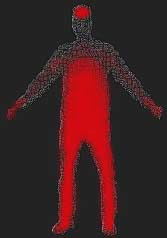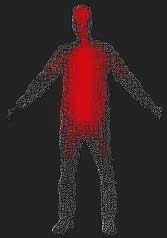

The fullness in the head that many astronauts experience, is due to the redistribution of body fluids in the absence of gravity. When one stands on the surface of the earth (1g) the body fluids tend to pool in the lower limbs and abdomen.

Figure 1. Distribution of body fluids
when standing in a 1-g gravity field.
Note that the brain is always well supplied with blood
since it cannot function without nutrients and oxygen.
The blood vessels in the lower limbs compensate for this hydrostatic pressure by increasing their muscle tone squeezing the blood back up toward the body. When you lie down, the blood tends to pool in the abdomen and thorax since there is less hydrostatic pressure. If you stand up quickly from a prone position (usually in the middle of the night, when you curse that last cup of tea you had before bedtime!) you may notice you feel dizzy and your heart starts pounding to compensate for the blood falling down into your legs!
However, in zero g, the compensatory mechanisms are still in place, but there is no hydrostatic pressure. Thus the blood is still being pushed back upwards-however the push is now unnecessarily forceful so the blood is forced into the thorax, neck and head and the thinner, less muscular vessels of the head become engorged with blood. This is why the nose gets blocked too- the nasal mucosa become fluid soaked and expands further into the nostrils to decrease air flow through the nose!

Figure 2. The distribution of blood in zero g.
The blood is forced into the thorax and into the head
causing the blood vessels to become engorged.
The distended veins were quite noticeable in Pete Conrads large and exposed forehead and he claimed the sensation was akin to " .hanging upside down from a tree branch when youre a kid ..
Interestingly, physiologists on Earth investigating the affects of zero g mimic it by confining subjects to bed rest with a 10o head-tilt to simulate this pattern of pooling.